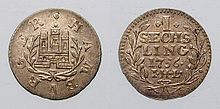Sextuplets
Sechsling , also Sößling , Søsling (Danish / Norwegian) or six , is the name of a coin type worth six pfennigs or half a groschen or half a shilling .
The sextuple was first minted in 1388 by the city of Lübeck . With the recess of 1392, the Sechsling club coin was issued by the Wendish Mint Association and, in addition to Lübeck, also by the cities of Hamburg , Lüneburg and Wismar . Other cities followed them.
The sextuple was minted until the end of the Wendish Münzverein after the middle of the 16th century. In the subsequent Imperial Coin Order , which is based on the Taler , it has the value of 1 ⁄ 60 Taler. Hamburg coined the last sextuplets from a billon alloy in 1855 .
Derived from the Prussian silver groschen of 12 pfennigs , the ten pfennig coin was popularly referred to as groschen in Germany after the introduction of the mark currency in 1871 . In the Berlin dialect, the term six for half a groschen was simply transferred to the 5-pfennig coin; one hears this designation occasionally in relation to the 5- cent nominal. Colloquially, some bridges in Berlin are still called the Six Bridge.
See also: Red Sigh , a six-pfennig piece from the Leipzig Mint
literature
- Wilhelm Jesse : The Wendish Mint Association . 2nd edition. Verlag Klinkhardt & Bärmann, Braunschweig 1967 (reprint of the Lübeck edition 1928).
